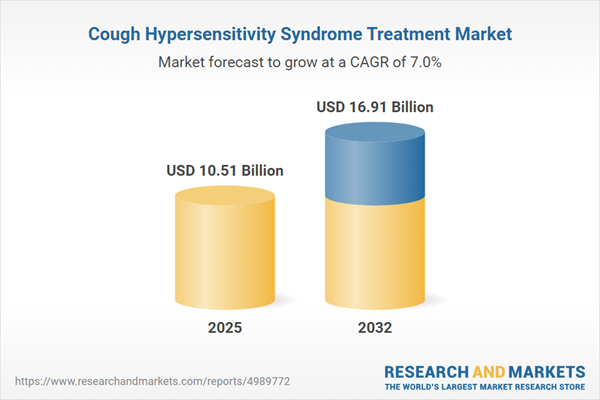Speak directly to the analyst to clarify any post sales queries you may have.
The Cough Hypersensitivity Syndrome Treatment Market is primed for substantial change as emerging therapies, evolving diagnostics, and patient-centered strategies jointly redefine best practices for clinical management and commercial success. Senior leaders in healthcare and life sciences will find the current market shaped by regulatory evolution, advanced delivery technologies, and nuanced supply chain realities.
Market Snapshot: Cough Hypersensitivity Syndrome Treatment Market Size and Growth
The Cough Hypersensitivity Syndrome Treatment Market grew from USD 9.82 billion in 2024 to USD 10.51 billion in 2025. It is expected to continue growing at a CAGR of 7.01%, reaching USD 16.91 billion by 2032. Growth is driven by the adoption of neuromodulatory therapeutics, increased focus on real-world outcomes, and widespread deployment of data-driven diagnostics.
Scope & Segmentation
- End User Settings: Home care environments, general hospitals, specialty hospitals, ENT clinics, pulmonology clinics
- Treatment Formulations: Inhalation (dry powder and metered dose inhalers), nebulizers, oral (capsule, tablet), syrup
- Prescription Types: Over the counter, prescription
- Patient Age Groups: Adults, geriatrics, pediatrics
- Regions Covered: Americas (including North America, Latin America), Europe, Middle East & Africa, Asia-Pacific
- Key Companies: Haleon plc, Reckitt Benckiser Group plc, Johnson & Johnson, Procter & Gamble Company, Bayer AG, Sanofi S.A., Pfizer Inc., Boehringer Ingelheim International GmbH, Viatris Inc., Zambon S.p.A.
Key Takeaways
- Innovations in neuromodulation and molecular targeting are bringing disease-modifying treatments into the clinical mainstream, moving beyond symptomatic relief.
- Patient-reported outcomes are fundamental to protocol design, steering dosing strategies and digital tool integration to improve daily adherence and satisfaction.
- Advanced diagnostics employing imaging and biomarker panels support early identification and adaptive therapy adjustment, fostering improved clinical outcomes.
- Digital health technologies enhance remote monitoring and intervention, enabling precision care that aligns with both patient needs and payer requirements.
- Distinct age-group and care setting dynamics demand strategies tailored to specific operational, dosing, and adherence challenges, particularly for pediatric, geriatric, and home-care segments.
- Strategic collaborations and value-based contracting are gaining momentum, aligning innovation with real-world effectiveness and facilitating stakeholder partnership.
Tariff Impact: Navigating Supply Chain and Pricing Pressures
Recent United States tariff policies have reconfigured global pharmaceutical supply chains, impacting the cost structure for active pharmaceutical ingredients and finished products. Manufacturers are revisiting supplier networks to optimize for duty exposure, considering factors like onshore production and raw material recycling to sustain competitiveness. These changes influence contract negotiations and reimbursement strategies, while driving innovation in procurement processes and logistics management to safeguard availability and affordability of therapies.
Methodology & Data Sources
This study integrates qualitative interviews with healthcare experts and quantitative analyses from clinical, regulatory, and production databases. Triangulation of interview insights, peer-reviewed literature, and industry data ensures clarity and relevance across all findings. Analytical techniques included outcome metric evaluations, scenario modeling for supply chain adaptation, and pricing sensitivity analysis.
Why This Report Matters
- Enables executives to benchmark strategic decisions with comprehensive insights into segmentation, regional demand, and evolving treatment platforms for Cough Hypersensitivity Syndrome.
- Provides actionable guidance for navigating regulatory changes, managing reimbursement complexities, and addressing patient-centered innovation priorities.
- Supports long-term business planning by synthesizing clinical trends, supply chain disruptions, and competitive developments into a clear, forward-focused narrative.
Conclusion
The Cough Hypersensitivity Syndrome Treatment Market stands at a turning point, driven by rapid therapeutic, diagnostic, and operational advancements. This report offers strategic clarity for leaders seeking to shape resilient, patient-centric, and innovative paths forward.
Additional Product Information:
- Purchase of this report includes 1 year online access with quarterly updates.
- This report can be updated on request. Please contact our Customer Experience team using the Ask a Question widget on our website.
Table of Contents
3. Executive Summary
4. Market Overview
7. Cumulative Impact of Artificial Intelligence 2025
Companies Mentioned
The companies profiled in this Cough Hypersensitivity Syndrome Treatment market report include:- Haleon plc
- Reckitt Benckiser Group plc
- Johnson & Johnson
- Procter & Gamble Company
- Bayer AG
- Sanofi S.A.
- Pfizer Inc.
- Boehringer Ingelheim International GmbH
- Viatris Inc.
- Zambon S.p.A.
Table Information
| Report Attribute | Details |
|---|---|
| No. of Pages | 198 |
| Published | October 2025 |
| Forecast Period | 2025 - 2032 |
| Estimated Market Value ( USD | $ 10.51 Billion |
| Forecasted Market Value ( USD | $ 16.91 Billion |
| Compound Annual Growth Rate | 7.0% |
| Regions Covered | Global |
| No. of Companies Mentioned | 11 |









